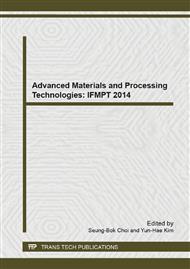[1]
Barthlott W, Neinhuis C. Purity of the sacred lotus or escape from contamination in biological surfaces . Planta , 1997, 202 ( 1) : 1- 8.
DOI: 10.1007/s004250050096
Google Scholar
[2]
Novotn P, Zita J, Krsa J, et al. Two-component transparent TiO2/ SiO2 and TiO2/ PDMS films as efficient photocatalysts for environmental cleaning . Applied Catalysis B: Environmental, 2008, 79(2): 179-185.
DOI: 10.1016/j.apcatb.2007.10.012
Google Scholar
[3]
Kubo W, Tatsuma T. Photocatalytic remote oxidation with various photocatalysts and enhancement of its activity. Journal of M aterials Chemistry, 2005, 15(30) : 3104-3108.
DOI: 10.1039/b504752h
Google Scholar
[4]
Hosono E, M atsuda H, Honma I, et al. Synthesis of a Perpendicular TiO2 Nanosheet Film with the Superhydrophilic Property without UV Irradiation . Langmuir, 2007, 23(14): 7447-7450.
DOI: 10.1021/la701117a
Google Scholar
[5]
Song S, Jing L, Li S, et al. Superhydrophilic anatase TiO2 film with the micro- and nanometer- scale hierarchical surface structure . Materials Letters, 2008, 62(20): 3503-3505.
DOI: 10.1016/j.matlet.2008.03.005
Google Scholar
[6]
Huang T,Huang W X,Zhou C,et al. Superhydrophilicity of TiO2/SiO2thin films: synergistic effect of SiO2and phase-separation-induced porous structure.Surface & Coatings Technology, 2012,213: 126-132.
DOI: 10.1016/j.surfcoat.2012.10.033
Google Scholar
[7]
Uchida H,Patel M N,May R A,et al. Highly-ordered me-soporous titania thin films prepared via surfactant assembly on conductive indium-tin-oxide/glass substrate and itsoptical properties.Thin Solid Films,2010,518(12): 3169-3176.
DOI: 10.1016/j.tsf.2009.08.050
Google Scholar
[8]
Wang J J,Wang D S,Wang J,et al. High transmittance and superhydrophilicity of porous TiO2/SiO2 bilayer films without UV irradiation.Surface&CoatingsTechnology,2011, 205(12): 3596-3599.
DOI: 10.1016/j.surfcoat.2010.12.033
Google Scholar
[9]
Cassie A B D, Baxter S. Wettability of porous surfaces . Transactions of the Faraday Society, 1944, 40: 546-51.
DOI: 10.1039/tf9444000546
Google Scholar


